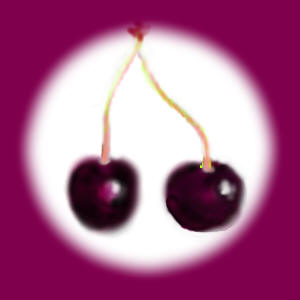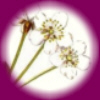CLICK: Color Control Color Choice

There is always something
of value in the woods.
Those somewhat scruffy little trees-so fluffy with
flowers in the spring - can really help you.
Of course, unless you are out
of pocket-leave their fruit for the birds.
Cherries
Along with Pomegranates, Prunus avium and the rest of the cherry family have a quite narrow relation to the rest of the plant DNA bank. There is actually no co-relative to the Pomegranate,which stands alone.

Cherry has a limited genetic family. Above, the flowers of Prunus avium ...
One of the
most interesting things I found out about Prunus avium is that it is
called Wild Cherry but that it has leaves, flowers and
fruit which are actually cherry shapes, whereas the true
Wild Cherry has Spring flowers which look more like a
Black Walnut flower- about 100 small white florets on
short bracts surrounding the three inch stem of
blooms.
The true Wild Cherry (our area is rife with them
on the sedgeways) is also called Black Choke Cherry,
Atlantic Ninebark, Rum Cherry, Cerasus Nigra and C.
sylvestris.
Its' tiny fruit are oval and more like a
small plum to look at.
At one point I was told that these
little trees were actully Umeboshi plums- the true source
of Chinese Plum sauce. I have tried the real Umeboshi
paste when I lived close to Chinatown in Toronto in my
youth, and the taste quite resembles the bitter, flat
taste of the Choke Cherry, though sugared and perhaps
simmered with peaches.
The link above is to an image bank
source.Very valuable.
Another image source you might
explore is The Vascular Plant Image Gallery at the Texas A
& M University.
When I was researching the Wild Cherry I found a huge list of valuable medicines which come from Cerasus nigra. Among many other themes, it is an analgesic, anodyne, blood cleanser, emetic, expectorant, febrifuge, vermifuge, good for womens' ailments, cancer, burns and measles.In other words the wise survivor-farmer should not be without one of these lovely trees. I have only seen one of them more than nine feet high, and its gorgeous bloom in the Spring is really impressive, as an 18 foot tree. Bear in mind, when you are planning herbal experiments of your own
I have had
an interesting experience with the true wild cherry. I
found what looked to be rose leaves poking out of the
gravel path in my former garden. I dug them out and found
that they stemmed from a Nectarine pit. Thinking with
excitement that I would grow a Nectarine in my back yard,
I raised it with love in my backyard until it was six
feet high, or until I vacated my rental.
The leaves
turned to slightly papery, tough leaves which resembled
pear leaves. The blossoms finally came in the fourth year
to resemble the wild cherry tassel of white florets, and
they did, indeed, leave small, glossy plum-shaped fruit.
I was not disappointed, but I have always wondered how in
hell the Wild Cherry came out of the Nectarine pit?

(I have included, in a cherry bark recipe link) the warning that too many
leaves or fruit are harmful in quantity- the leaves and
fruit contain hydrogen cyanide which when overdosed can
cause respiratory failure or even death.
Prunus avium
does not show any contra-indications in two herb books,
by comparison, but you know what happens to the digestion
when you eat a pound of cherries.
Neither would you swig
back a bottle of cough syrup as the expectorant produced
from cherry bark is potent enough from a tablespoon.
Cherries. I just buy as many as I
can afford when the markets present their exquisite, slightly
almond-tasting glossy fruits, tumbled as they are with their stems still
attached so that one may dangle one or two above the lovers eager lips,
perhaps under a warm sky sprinkled with stars.
What I did not know when I
purchased my coveted award of expensive summer cherries is that sweet cherries inhibit the
buildup of LDL (Low-Density Lipoprotein)
Add the address:
"/natural_food_guide_fruitcommon.htm "to the address bar
when you reach the Natural Hub link..
They are in fact
the third highest tested for an LDL inhibitor, and reduce
cancer risk, simply in the delicious act of devouring
them.
The herb and natural foods books used to say that
an almond a day kept the Doctor away, but no-one, at the
time, thought of the almond taste in cherries.
We live with so
many "miracle cures " all about us, just
growing wild all over the woods, and often called a
nuisance by gardeners and farmers.
Way back in the hip
seventies, I resolved to be a survivor, to know what the
natual world had to offer in the event of illness from
nuclear fallout, monoxide pollution and water
contamination.
The frightening list was endless. I
discovered the lovely world of herbs and natural foods.
My Dad was from the Medical side of the world and
continuously called me a crank, and the Natural Foods
advisors "quacks".
HA! I guess many of us have
shown our forebears what excellent cuisine truly offers
in terms of health balance, immunity and maintenance.
Our
wierd herb remedies have become medicinal realities. Our
health has reflected the miraculous in the world.
I know
that I would have literally died without my herbal and
freak foods backup; for example, like the time I
discovered that Yarrow tea and Evening Primrose Oil
powerfully expelled a potentially dangerous calciferous
factor in a problem leading to MS.
Perhaps
you think of these personal discoveries as waffle, but
even a hobbyist can discover, through personal
experimentation and even through insight meditation how
to use a substance in a way never supposed possible
before, since scientific research takes a lot of time and
money.
In the back of my mind, there is a little
meditation I once did on ancient Pomegranates and a great
healer, Christ. If I subsequently put Pomegranates
together with Prunus avium or Wild Cherry, will I have an
ultra-remedy for chest ailments? Hmmm...

Sour Cherry Sweet Cherry
Sweet Cherry
Black Chokecherry

"The sour cherry is
squatter than the sweet cherry; both have a typical
spread of about 30 ft., but the sour rarely grows taller
than 25 ft. Deep green, long serrated leaves, with
attractive rust-brown bark make the cherry a popular
ornamental. Most varieties bloom late and ripen early."
"The sour cherry is shorter than the
sweet cherry; both have a typical spread of about 30 ft.
Deep green, long serrated leaves, with attractive
rust-brown bark make the cherry a popular ornamental.
Flowers are prolific and white. "
"The genus Aronia belongs to the Rosaceae family. Aronia includes a number of plants known as chokeberries. They are not to be confused with the chokecherry, a Prunus species.
The black chokeberry, A. melanocarpa, is the most pleasing to one's tongue and stomach.
Chokeberry species are indigenous to northeastern North America, from Nova Scotia to Michigan to northern Florida. But, Aronia have not been commercially cultivated in the U.S. since the turn of the century, and the scarce home cultivation has been mainly for ornamental effect.
A. melanocarpa today is much more popular in Eastern Europe and Russia (especially Siberia) than its native land. One company is attempting to sell "Aronia juice" in the United States. See The Wildland juice company's Web site (http://www.aronia.com )

The above notepad is from copyright:
Edible
Landscaping Index
Prunus serotina has flowers like the Black Walnut
Photo by: Northdays Image: Natural Light Photos
